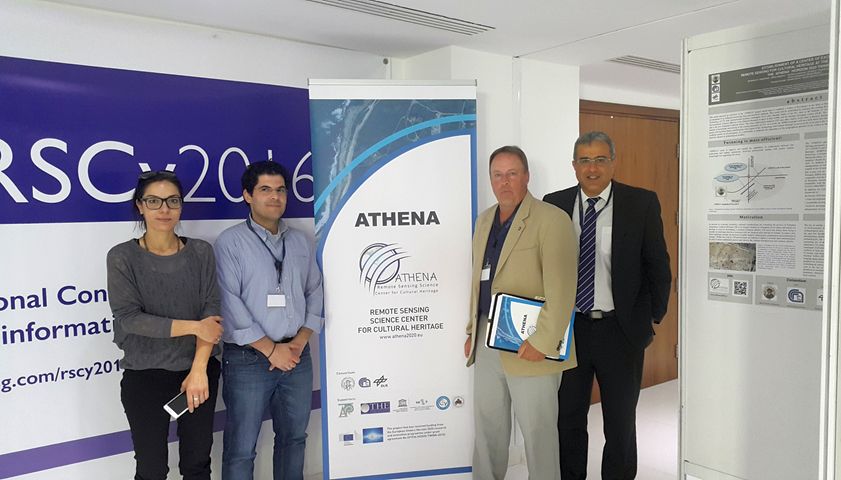Main Issues and results from the discussion with the Participants ATHENA Copernicus Workshop Paphos, Cyprus, April 7th 2016
Background
The workshop is within the series of workshops and trainings of the ATHENA Twinning project[1] funded by H2020. The workshop was conducted during the Fourth International Conference on Remote Sensing and Geoinformation of Environment RSCy2016[2].
The ATHENA Workshop is a one-day general introduction to the European Copernicus Earth observation program, focusing on the topics of the H2020 ATHENA project, such as:
- Preservation and monitoring of Cultural Heritage
- Archaeological research
- Protection from archaeological looting
- Eastern Mediterranean region
The German Aerospace Center (DLR) – ATHENA twinning partner – alongside guest speakers from European Space Agency (ESA) and the European Commission (EC) presented aspects of Copernicus programme, such as:
- Sentinel space segment
- Contributing missions and access to the Copernicus data
- Core and collaborative ground segment
- Data policy and access to the data
- Core Services with focus on those of relevance for ATHENA
Major Points of Discussion and Results
The following issues were discussed at the end of the workshop, during a one-hour discussion with the participants
General Issues on Copernicus
Amongst others, the following general issues were raised during the discussion:
- Access to Copernicus Data: The access to Sentinel data will be improved on a European scale by the new initiative of the European Commission to better coordinate and merge core and collaborative data access points;
- Access to contributing mission data: this data is purchased by the Commission/ESA with a certain license to be used for the Copernicus Core Services. Under certain restrictions the data can be used by H2020 projects and governmental agencies:
European representation of World Heritage Sites and Archaeological issues:
The areas and services in Copernicus are represented by European Agencies (not necessarily Agencies of the Commission) and European Interest groups. Based on a legal procedure, the Commission has entrusted to these agencies the resources to conduct parts of the Copernicus programme, including the Copernicus Core Services. For instance, the civil security services have been delegated to FRONTEX, EMSA and SatCen (from mid of 2016 onwards). At the present moment, it seems that there is no single body (e.g. a European wide agency) dealing with cultural heritage and specifically with World Heritage Sites in Europe. Participants noted that on the international scale there are several interest groups such as CIPA and ICOMOS which are indeed active and have European members. However, no organization specifically dealing with European interests in this matter was known to the participants at the time of the discussion (few comments and players have been mentioned afterwards[3]).
Arguments for including World Heritage Monitoring in Copernicus
Several arguments to promote the inclusion of WH Monitoring into Copernicus were discussed. In the end, these arguments need to be tangible in terms of bringing a socio-economic benefit. These arguments include:
- Tourism: There are Pro’s and Con’s for encouraging tourism to preserve WHS
- Cultural heritage: at times when the European Society raises the issue of “European Identity” and “European Culture”, relevant cultural sites in Europe (including WHS) should be monitored for their better preservation, preventive maintenance and management
- Security: Looting and illegal trading of archaeologic artefacts can be a significant source of funding for criminal and terrorist groups
- Holistic approach: cultural heritage, especially archaeological sites, include large portions of land. They should be observed on a larger geographical scale in order to consider all possible threats and to provide a more complete monitoring based on a holistic approach.
Interest of the European Commission to include World Heritage Monitoring in the Copernicus Core Services:
The European Commission representative (who unfortunately couldn’t make it to the workshop due to the closure of the Brussels airport), issued a written statement:
- There has been a growing interest in the use of satellite observation for monitoring cultural heritage, in particular seen the conflicts in the middle East and the difficulty in assessing damage in-situ.
- Monitoring of Cultural Heritage – particularly related to damage assessment in conflict zones – will be one of the services accessible through SEA (Support to EU External Actions) as from mid-2016.
- Until then, in specific cases it could be possible to use the Copernicus Emergency Management Service, to provide reference material also in support to the EU External Action Service and Regional desk officers.
- We are keen in developing further contacts with the R&D community to explore how satellite observations, merged with other sources of information, may help us to increase awareness and contribute to the preservation of our World cultural heritage.
This statement was the basis for further discussion on how World Heritage Monitoring (WHM for short) can be embedded in the Copernicus Core Services and which of the current services would be best to implement WHM.
It should be noted that the European Agencies, executing the Core Services, are also contracting the generation of the maps and products to industrial consortia by an open tender procedure. Academia might be involved in definition of the products, in validating the results and supporting European geo-information industry.
Defining a future WHM Service
Prior to including WHM into the Copernicus Core Services, several issues need to be addressed. These include:
- Organizing a European consensus on this issue, especially with the national representatives in the Copernicus User Fora
- Engaging the end-users (e.g. national and regional institutions engaged in WHS preservation and management)
- Identifying which products or services need to be conducted and which sites (in Europe: all, use the UNESCO WHS list, outside Europe) need to be monitored
- Defining a common metrics and procedures for the products and services
- Defining a calibration and verification procedure
Further ways ahead
The issues raised during the ATHENA Copernicus Workshop can be considered a basis at the European level. Further action needs to be taken to imbed the idea of a permanent and funded European service at the Copernicus level. These actions include stakeholder consultation and possible initial small case studies to identify the major points, some of them also raised during this workshop.
[1] www.athena2020.eu
[2] www.cyprusremotesensing.com/rscy2016
[3] E.g. Joint Programming Initiative (JPI) on Cultural Heritage and Global change coordinated by the Italian Ministry for Cultural Heritage and Activities (http://www.jpi-culturalheritage.eu/about-us-2/vision/). As well as a recent (September 2015) resolution of European Parliament entitled “Towards an integrated approach to cultural heritage for Europe”


